Fujifilm Finepix SL280 Review
Fujifilm Finepix SL280 Introduction
The Fuji Finepix SL280 is a 14 megapixels digital camera with a stabilized 28X optical zoom lens, equivalent to 24-672mm. This relatively compact model is ergonomically designed with a deep hand-grip and features both a large LCD and a small EVF. The SL280 still features full manual-controls and custom white-balance, things which are slowly disappearing from modern ultra-zooms. This digital camera also records 720p HD video at 30 FPS, which is now the norm among CCD-based cameras.
This ultra-zoom belongs to Fuji's new SL-series which is a step above the S-series and below the high-speed HS-series. Fuji introduced simultaneously three SL-series digital cameras which only differ in optical zoom. These models are not distributed in all regions though, so while the 28X optical zoom SL280 reviewed here is available in Canada, the US gets the 30X optical zoom SL300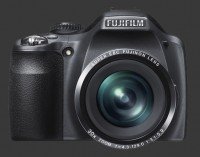
Fujifilm Finepix SL300 instead. An SL240
Fujifilm Finepix SL240 with 24X optical zoom and SL260
Fujifilm Finepix SL260 with 26X optical zoom are also available in the UK. Either check local availability or order the SL300 from B&H Photo which ships internationally.
The SL-series feature new ultra-zoom lenses with an electronic zoom controller on the barrel for maximum hand-holding stability. They also feature a hot-shoe for using add-on flashes or other external lighting accessories. These are the lowest cost models to do so.
This express digital camera review analyses the features, ergonomics, usability, performance and image quality of the Fuji Finepix SL280. This is expected to apply equally to all SL-series models.
Fuji Finepix SL280 Features
Sensor & Exposure
- 14 Megapixels CCD sensor
- ISO 64 to 1600 sensitivity, at full-resolution
- ISO 3200 and 6400 at 3 megapixels
- 1/2000-8s Shutter-speeds
- PASM Exposure modes
- Program-Shift in P mode
- Multi-Segment, Average, Spot & Face-Detect metering
- Exposure-Compensation, ±2 in 1/3 EV increments
- Flash-Compensation, ±2/3 in 1/3 EV increments
- Exposure Bracketing, 3 frames, maximum ±1 EV
- Auto, Forced, Off or Slow-Sync flash modes
- Optional Redeye reduction
Lens
- 28X Optical zoom range
- Ultra-Wide-Angle 24-672mmSL300: 720mm
SL260: 624mm
SL240: 576mm equivalent - Built-In Stabilization, Shooting-Only or Continuous
- F/3.1-5.9 Fixed aperture varies with zoom
- Aperture simulated by 2 ND filters
- 40cm-2.8m Normal minimal focus distance
- 7cm Normal Macro mode
- 2cm Super-Macro mode
Image Parameters
- Automatic, 6 presetsSunny (Fine), Shade, Fluorescent 1, Fluorescent 2, Fluorescent 3, Incandescent and custom white-balance
- Standard, Chrome, B&W color modes
- 3 Sharpness levels
Video
- 1280x720, 640x480 or 320x240 @ 30 FPS Video resolutions
- Mono Sound, Built-in microphone
- Single-Shot or Continuous Autofocus
Focus
- Single-Shot Center-Focus
- Single-Shot Automatic Focus Selection
- Single-Shot Manual Focus Selection
- Continuous Autofocus
- Tracking Autofocus
- Face-Detect Autofocus
- AF Assist-Lamp
Drive
- Single-shot
- 1.2 FPS Continuous, Unlimted, Top-6 or Final-6
- 3.3 FPS Continuous @ 7MP, Max 20 frames
- 8 FPS Continuous @ 3 MP, Max 40 frames
- Self-Timer, 2s or 10s
Display & Viewfinder
- 3" LCD, 460K Pixels, 97% Coverage
- 0.2" EVF, 200K Pixels, 97% Coverage
- Live histogram during EC
- Grid or HD Guidelines
- Adjustable LCD brightness
- 30 or 60 FPS Refresh rate
Connectivity
- HDMI (1080i) output
- A/V (NTSC / PAL) output
- USB 2.0 connectivity
Misc
- SDXC memory
- Lithium-Ion battery
- Automatic Panorama Stitching
- Panorama Assist Mode
- 18 Scene Modes
- Blink Detection
Fujifilm Finepix SL280 Usability - How easy is it to use?
The Fuji Finepix SL280 has a classic ultra-zoom style which looks like a miniaturized DSLR. This makes it noticeably bigger than a travel zoom but lets it have a zoom reach that is rarely achieved by such cameras.
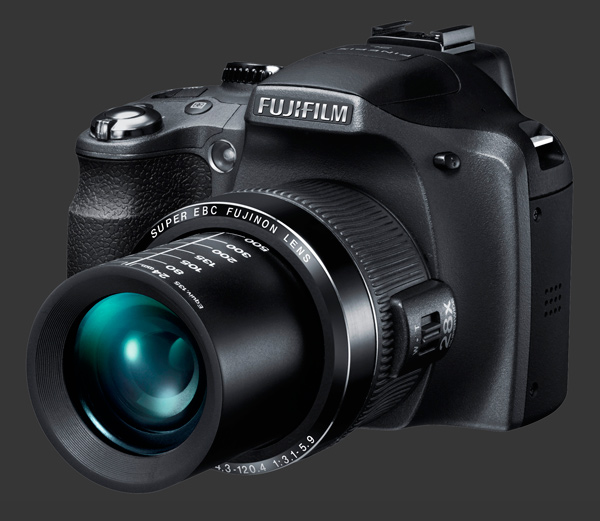
Ergonomics
This digital camera has a deep sculpted hand-grip which makes it comfortable to hold securely. This is very important for an ultra-zoom since it improves stability which is needed towards the long end of the zoom. The solid lens barrel another point of support to use the SL280 with both hands. It is covered with texturized rubber which provides excellent traction. New to the SL-series is a zoom controller on the outer side of the lens barrel. The entire camera feels rather solid, similarly to competing ultra-zooms. It has a good weight for its size yet is light enough to carry around for prolonged periods.
The hand-grip houses a number of controls including a standard two-stage shutter-release. Around it is a rotating zoom controller which moves the lens electronically in 40 coarse steps, making precise framing not always possible. Just behind are the easily accessible Instant-Zoom and Drive-Mode buttons occupying prime real-estate. One of these buttons should have been EC and the other probably ISO. The Instant-Zoom button cycles through 4 preset digital enlargements, while the Drive-Mode button cycles through 7 drive modes which surprisingly does not include any self-timers. Just behind is the sliding power-switch which has no chance of accidental activation.
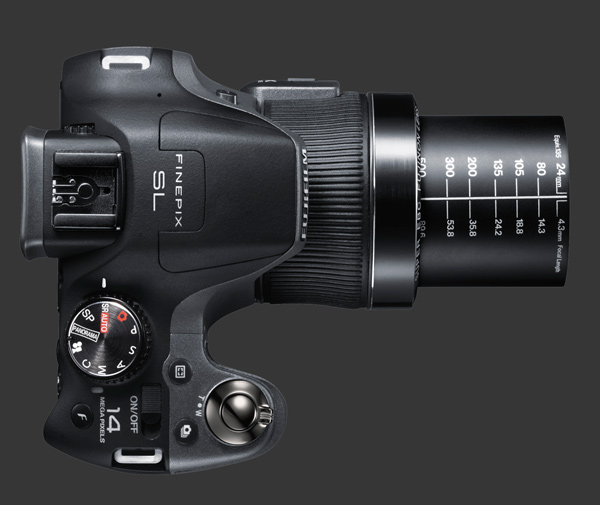
The top of the Finepix SL280 has a true mode-dial with 10 positions. The mode dial is easy to move using your thumb while holding the camera securely. It has good detents which means it will not move accidentally either. On a slant next to the mode-dial is the Finepix button. This one brings up a quick menu of 3 items: ISO, Image Size and Finepix Color. Normally such menu is used to access frequently modified settings, so we expected to see WB, FC and Metering there too.
The rear of this camera offers 4 buttons plus a 4-way controller with central OK button. All these buttons have a good size and provide positive feedback. The EC button is easily reachable with the thumb. Since there is no control-dial on the SL280, directions of the 4-way controller is used to set EC and change exposure parameters.
The top button manually toggles between the rear LCD and EVF. Near the bottom of the camera are the Display and Playback button which behave just as expected. Playback mode is shooting-priority, meaning that the camera immediately returns to Capture mode with a touch of the shutter-release.
The 4-way controller below is used to navigate the menu system. Outside of the menu, which is invoked by the central OK/Menu button, each direction is usually assigned a function:
- Up: Does nothing at all in Capture mode. Prompts for deletion in Playback mode.
- Right: Cycles through flash modes when the flash is raised. Options are Auto, Forced, Slow-Sync. An option in the Setup menu controls whether redeye reduction is used or not along with all these options. There is no Off option because that is automatic when the flash is closed.
- Down: Brings up the self-timer menu and cycles through each option: Off, 10s or 2s. Annoyingly, self-timers reset after each use.
- Left: Cycles through Normal, Macro and Super-Macro focus modes. The Super-Macro mode automatically zooms out completely which allows the SL280 to focus down to 2cm from the lens.
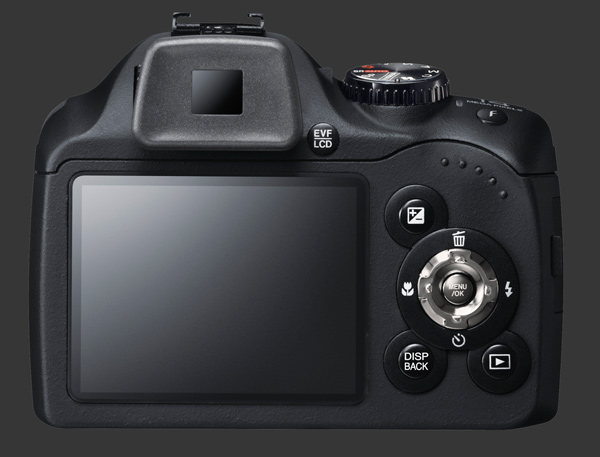
There are a number of important controls which unfortunately require a trip to the menu system: White-Balance, Metering, Bracketing Steps and Flash Compensation. Nicely though, since self-timers and exposure bracketing are set by separate menus, they can be used together. The camera waits for the delay and fires three shots as quickly as possible.
Functionality
The Fuji Finepix SL280 features manual-controls with Program, Aperture-Priority, Shutter-Priority and Manual exposure modes. The mode-dial selects one of these exposure modes, plus others that are discussed further down in this review.
While the SL280 has a shutter-speed range of 1/2000s-8s, it actually lacks a true aperture. Instead, this ultra-zoom simulates stopping-down aperture using 2 ND filters. This has several important consequences. The first one is that depth-of-field is fixed by the zoom position and focus distance. Therefore changing the simulated aperture has no effect on depth-of-field. The second is that the camera requires control over ISO to achieve a proper exposure when shutter-speed is fixed.
Normally ISO is manually controllable from 64 to 1600 at full-resolution and up to 6400 at 3 megapixels. This is true in Program, Aperture-Priority and Manual exposure modes. There are also two Auto ISO modes, one that sets the ISO up to 400, the other up to 800. These modes are available in Program and Shutter-Priority modes. Particularly, these are the only two ISO options for Shutter-Priority. Otherwise, ISO is always fully automatic.
Like most ultra-zooms, there are no control-dials at all on the SL280. To modify exposure parameters, one must press the EC button first. Then, the 4-way controller is used to dial EC using the left or right directions and the exposure parameter using the up and down buttons. Obviously in Manual mode, EC does not apply, the vertical buttons change shutter-speed while the horizontal ones toggle between simulated apertures. Oddly, there are 2 simulated aperture near wide-angle and three near telephoto.
The fully automatic mode, marked by a red camera on the mode-dial, is similar to Program mode except that ISO is locked on Auto and neither EC, FC, White-Balance nor Metering can be changed. The SR Auto mode stands for Automatic Scene-Recognition, it locks pretty much all camera settings except image size and color mode. In this mode, the camera constantly analyzes the scene to determine the type of photo. If it detects a face, it always choose portrait mode. It has no trouble recognizing multiple camera-facing people and does well with profiles. It rarely recognizes tilted faces though.
The SP position on the mode-dial lets the user choose between 17 scene modes. One notable mode is a Fuji classic, the Natural Light & Flash mode, which takes two shots in succession, one with the flash, the other without. Also noteworthy is that Fuji distinguishes Handheld Night and Tripod Night modes. The former uses a high ISO to reduce camera shake, the latter a slow shutter-speed to get higher image quality.
Panorama mode stitches three shots taken from left-to-right or right-to-left in landscape orientation directly in camera. There are two ways for the SL280 to do this. One is called Automatic which lets the camera take the second and third shots as soon as the camera has been sufficiently panned. The other, called Manual, shows an overlay of the previously taken image to help align things but the user must press the shutter each time. In both cases, this camera creates a low resolution panorama.
There is a Custom mode that can store any other exposure mode and settings for convenience. Finally, there is a dedicated Movie mode which lets the camera record videos and always show the correct framing.
Display & Viewfinder
This ultra-zoom includes a large 3" LCD with 460K pixels. Normal visibility is average and susceptible to bright light. Motion is fluid with a high refresh rate. There is also a miniscule 0.2" EVF with 200K pixels which is quite dim but given that it gets shielded from ambient light, this is not a huge problem. Motion is just as fluid as the LCD and precision is comparable. Colors are a little off with a slight yellow tint to them, so adjusting WB based on the EVF is not so reliable. Both displays react to changes in EC but the SL280 makes no attempt to keep the preview accurate while in manual or semi-automatic modes.
Misc
There is plastic tripod mount at the bottom of this camera. It is not aligned with the optical center of the lens which is problematic for panoramic photography. The camera is powered by a proprietary Lithium-Ion battery. The camera accepts SDXC memory cards. A solid door at the bottom of the camera gives access to both.
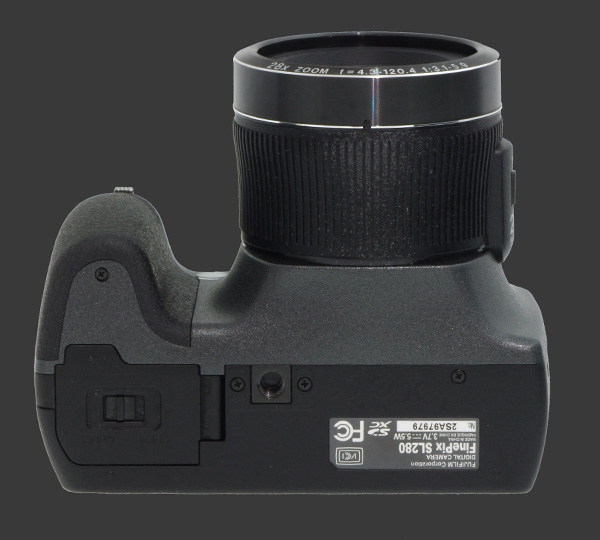
Fujifilm Finepix SL280 Performance - How well does it take pictures?
The Fuji Finepix SL280 is a capable value ultra-zoom defined by its lens and form-factor. There are a number of HD-capable ultra-zooms with stabilized ultra-wide-angle lenses that feature a hot-shoe but - with the exception of this SL-series - they are all higher-end models with more controls and, most importantly, a significantly higher price tag.
Image Quality
The 14 megapixels CCD on the SL280 is probably quite noisy but Fuji's aggressive noise-reduction replaces image noise by softness at all sensitivities. At ISO 64 and 100, softness is minor and, considering the high-resolution of this digital camera, delivers usable results for common print sizes up to moderately large prints. ISO 200 is only slightly softer and remains completely usable.
The ISO 400 setting shows increased softness and reduces potential print sizes. ISO 800 shows a significant increase in softness, limiting its usefulness to much smaller print sizes and typical online sharing. Sensitivities from 1600 onwards are best avoided and show blotchiness even in small prints.
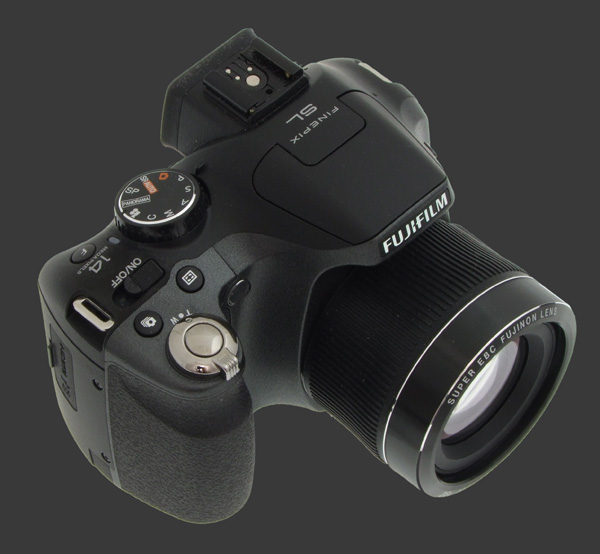
In the case of this ultra-zoom, ISO 64 and 100 are capable of keeping an acceptable level of details, providing the lens lets it through. The 28X optical zoom lens is very sharp from its ultra-wide end to around 4X. It then becomes a bit softer until about 8X. After that, the entire image shows some general softness which is only visible in the largest print sizes. Softness remains similar until 24X where it jumps and becomes noticeable even in mid-sized prints, still be then the camera already reached a whopping 576mm-equivalent focal-length.
Edge softness reaches deeper towards the center than usual but is not very pronounced. Since the lens is much sharper towards wide-angle, it is more noticeable at such focal-lengths. This lens shows some very gentle barrel distortion at the ultra-wide end. It becomes distortion-free from 1.5X to 3X when pincushion distortion start appearing. It remains very slight until the end of the optical zoom range.
There are virtually no chromatic aberrations, even in areas where expected, suggesting the SL280 applies processing to remove them. Vignetting is not a problem either.
Color accuracy is quite good. In Standard mode both colors and contrast appear natural. In Chrome mode, colors become slightly more saturated but contrast greatly increases. This gives more punch to results for scenes of low contrast while keeping colors sufficiently close to reality. For most scenes though, this leads to clipped shadows. Automatic white-balance is not great, working well outdoors but generally leaving a warm cast under artificial light. Custom white-balance is close to perfect though.
Multi-Segment Metering of the SL280 is very good. It is reliable and not much EC is required under typical conditions. Resulting exposures are generally bright which occasionally causes blown highlights but much less than usual. Metering is strongly influenced by the center of the frame, so some under-exposure happens when an unusually bright object finds itself there.
Speed & Performance
Speed of the SL280 is on the slow side. Its performance is characterized by the following measurements:
- Power On: Just under 2s. Average.
- Autofocus: Under ½s in good light near wide-angle but typically closer to ¾s. Over 1s in low-light. Good to very slow.
- Zoom: About 3s from widest to longest. Very reasonable for such a long zoom.
- Image Shutter-Lag: Quick. Good.
- Video Shutter-Lag: Instant. Excellent.
- Black Out: 1s. A bit below average.
- Shot-to-Shot speed: 2½s, sometimes longer. Slow to very slow.
- Time-to-first shot: 3s. Below average.
- Playback: About ½s to enter, ¾ to exit. A little below average.
- Power Off: Under 1s from wide-angle. Good. Add 3s more from telephoto.
Buttons generally respond with slight but tolerable lag. The camera does stay unresponsive while its writing out images or applying extra noise-reduction for exposures longer than a fraction of a second. Focus is obviously highly variable and can easily cause missed shots towards the long end of the zoom.
Full resolution continuous drives modes are unusable since the display severely lags the action. By reducing the resolution to 7 MP, the lag becomes shorter but still insufficient for following true action. The 8 FPS drive mode which drops resolution further to 3 MP exhibits an unfortunate 1½s lag before starting to shoot but eventually keeps up with action very well. It does take up to 35 seconds to clear the buffer after that.
The battery-life of the Fuji Finepix SL280 is average for a modern digital camera but short when compared to similar ultra-zooms. It can take up to 300 shots-per-charge according to the CIPA standard.
Fujifilm Finepix SL280 Conclusion
The Fuji Finepix SL280 is a great value for its feature set. It packs a stabilized ultra-wide-angle 28X optical zoom lens with full manual-controls, spot-metering, shutter-speeds from 1/2000s to 8s, a hot-shoe and HD video for less than $210 CDN which is truly exceptional. The hot-shoe is highly beneficial for family portraits using an add-on flash.
While the performance of the SL280 is acceptable for general photography involving relatively still subjects in good light, it certainly does not compare with cameras having a similar feature set. Since most of them cost roughly twice as much, that is easily understandable. Fuji makes high-end ultra-zooms riddled with features such as the recently reviewed HS30 EXR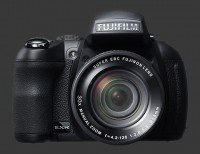
Fujifilm Finepix HS30 EXR which would be a great choice if budget permits.
One advantage other than price of the Fuji Finepix SL280 is its simplicity and ergonomics. This digital camera handles well and its controls are simple and, for the most part, fairly direct. Also, the miniature DSLR-style and EVF give it excellent stability when shooting towards the long end of the zoom. In the end, the SL280 provides a unique price-point for all the features it has to offer.
 |
Please Support Neocamera
All information on Neocamera is provided free of charge yet running this website is a huge endeavor. Purchases made via affiliate links found throughout the site help keep it running and up-to-date. There is no additional cost to you, so please consider buying via these links to our affilates:
If you found any information on this site valuable and did not purchase via our affiliate links, please considering donating via PayPal:
Any amount will be greatly appreaciated. Thank you for your support!
Fujifilm SL280 Highlights
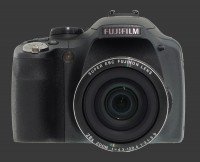
Sensor-Size: 6 x 5mm

Actual size when viewed at 100 DPI
| 14 Megapixels Ultra Zoom | ISO 64-1600 |
| 28X Ultra-Wide Optical Zoom | Shutter 1/2000-8s |
| Built-in Stabilization | Full manual controls |
| 0.20" Built-in EVF 200K Pixels | Custom white-balance |
| 1.2 FPS Drive, 6 Images | Spot-Metering |
| 1280x720 @ 30 FPS Video Recording | Hot-Shoe |
| 3" LCD 460K Pixels | Lithium-Ion Battery |
| Secure Digital Extended Capacity |
Updates
2025.01.18

Fujifilm GFX 2025 Lens Roundup
Lens Review roundup of Fujifilm GFX Medium-Format lenses. Quality, performance and handling of the GF20-35mm F/4R WR, GF30mm F/3.5 Tilt-Shift and the GF55mm F/1.7.
2024.11.18

Best 2024 Photography Gifts for Every Budget
Great gifts for photographers and photo enthusiasts selected for every budget among the best products of 2024.
2024.08.07

Eye Protection Tips for Professional Photographers
The four main considerations for professional photographers regarding eyewear.
2024.07.14

Fujifilm X100VI Review
Flagship fixed-lens compact digital camera with a 40 MP sensor and Image-Stabilization, a first for the series. Retro design featuring dual control-dials, plus direct ISO, Shutter-Speed and EC dials. Its hybrid viewfinder can switch between EVF and OVF mode.
2024.05.09

Fujifilm GFX100 II Review
Flagship 102 Megapixels Medium-Format Mirrorless Digital Camera with 8-Stop 5-Axis IBIS, 8 FPS Drive, 8K Video and 400 MP Super-Resolution capture in a weatherproof and freezeproof body with dual control-dials and dual memory-card slots.
2024.04.03

Fujifilm X-T5 Review
Newest Fujifilm flagship boasting a 40 MP APS-C sensor, 5-axis IBIS with 7-stop efficiency, 15 FPS continuous drive, 6.2K Video capture, dual control-dials and dual SDXC UHS-II slots in a sturdy weatherproof and freezeproof body.
2023.11.20

Best Digital Cameras of 2023
Find out which are the Best Digital Cameras of 2023. All the new Mirrorless Digital Cameras from entry-level to high-end professional.
2023.07.10

Fujifilm X-H2 Review
40 Megapixels APS-C Hybrid Mirrorless Digital Camera with 7-stop IBIS. Fastest shutter ever and 8K video capture. Large builtin EVF with 0.8X magnification and 5.8 MP, plus an Eye-Start Sensor. Packed with features and large number of controls in a weatherproof and freezeproof body.
2023.05.07

Sony FE 20-70mm F/4G Review
Review of the unique Sony FE 20-70mm F/4G lens. The optical zoom of this lens spans ultra-wide-angle and medium focal-length coverage, making it one of the most versatile Full-Frame lenses on the market.
2023.01.15

Huion Inspiroy Dial 2 Review
Review of the Huion Inspiroy Dial 2 tablet, a medium sized drawing surface with dual dials and customizable buttons. Connects via USB-C or Bluetooth 5.0 with Windows, Linux and Android support.
2022.12.08

How to Pack for a Photo Trip
Find out how to pack for a travel photography trip, carry your gear safely while meeting airline regulations.
2022.11.13

Best Digital Cameras of 2022
The best digital cameras of 2022. A short list of the most outstanding models in their respective categories. Choose one for yourself or as a gift.














